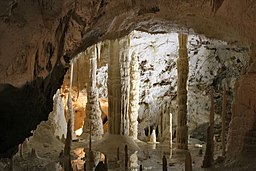Frasassi
| Grotte di Frasassi (Frasassi Caves) |
|
|---|---|

View of the caves
|
|
|
Location of the caves in Italy
|
|
| Location |
(AN, Marche, Italy) |
| Coordinates | 43°24′03″N 12°57′43″E / 43.40083°N 12.96194°ECoordinates: 43°24′03″N 12°57′43″E / 43.40083°N 12.96194°E |
| Depth | 400 m |
| Elevation | 300 m |
| Discovery | 1971 |
| Geology | Karst cave |
| Entrances | 1 |
| Access | Public |
| Show cave opened | 1974 |
| Show cave length | 5,000 m |
| Website | Official website |
The Frasassi Caves (Italian: Grotte di Frasassi) are a remarkable karst cave system in the municipality of Genga, Italy, in the province of Ancona, Marche. They are among the most famous show caves in Italy.
The caves, discovered by a group of Ancona speleologists in 1971, are situated 7 kilometres (4 miles) south of Genga, near the civil parish of San Vittore and the Genga-San Vittore railway station (Rome-Ancona line).
Rich in water, the cave system is particularly well endowed with stalactites and stalagmites.
Near the entrance to the caves are two sanctuary-chapels: one is the 1029 Santuario di Santa Maria infra Saxa (Sanctuary of Holy Mary under the Rock) and the second is an 1828 Neoclassical architecture formal temple, known as Tempietto del Valadier.
The Frassisi cave system includes a number of named chambers, including the following:
The cave has been used to conduct experiments in chronobiology. Among the cavers that have spent considerable amount of time inside the cave is the Italian sociologist Maurizio Montalbini, who died in 2009.
"Organ pipes"
Water well
View
Frasassi is partnered with several sister caves around the world:
...
Wikipedia

